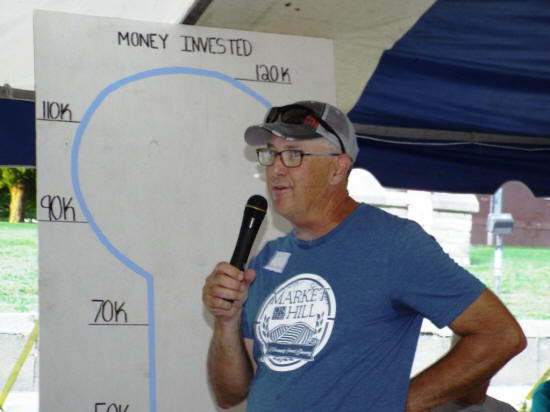Market on the Hill kicks off with strong
positive support from the community
 Send a link to a friend
Send a link to a friend
 [September 19, 2019] [September 19, 2019]
For the last several months there has been talk in Mount Pulaski of
coming up with a way to bring a grocery store back into the town. The
local IGA store closed two years ago and since that time the primary
resource for food products in the town are the Dollar General Store and
the items sold at the Casey’s convenience store. While those two
locations do offer a variety of processed foods and convenience
products, they both lack in some important products for good nutrition -
fresh vegetables and meats.
On Thursday, September 12th, the interim board of directors for Market
on the Hill hosted a social hour on the Mount Pulaski Courthouse Square
to introduce the plan they have come up with to answer the need for
fresh foods. In addition to offering fresh, the market plan includes
using local sources. Foods grown mostly in Logan County will be offered
along with a small selection of grocery items.
At the social hour, Tom Martin, who is the current president spoke about
the plan and how the group plans to raise the funding for the small
grocery store. The group has determined that they need to raise $120,000
in order to open the doors of the new market. They are working to raise
that money through three avenues. The store will be a local cooperative,
so the board is selling memberships and also two types of stock, common
stock and preferred stock.

In addition to the Thursday social hour, the group also hosted an open
house type event at the store location at 125 South Lafayette on both
Friday and Saturday evenings during the Mount Pulaski Fall Festival.
On Saturday evening, an excited Martin reported that since the Thursday
evening event, the group had collected $60,000 in investment pledges.
Martin had on Thursday evening told guests that the board was asking for
pledges and that those pledges would be legally binding documents
guaranteeing the investor would follow through. However, the board would
not be asking for all the money right away, it would be requested later
and when needed.
Martin said Saturday that the board was thrilled with what they had
collected, and also they had talked with potential investors who
indicated verbally that they would be supporting the market plan, they
just wanted a little more time to study the plan and decide on their
level of investment.
With the fundraising effort immediately reaching the half-way point.
Martin said the board is ready to move forward with the interior design
and remodel project for the shop.
On Thursday evening Martin had told guests that the group was utilizing
a cash award from the Mount Pulaski Economic Development Council in the
amount of $5,000 to get the building rented and start the gutting work
to open up the floor plan for the grocery store. He said that the board
had taken a leap of faith in making these initial moves, confident that
they would be able to raise the money needed to move forward.
Now that they have the $60,000, Martin said Saturday that the group will
hire a professional to assist them in creating the interior layout for
the store. He showed a mock-up of what they hope to have, but said that
the professional may have a better floor plan that will assist the store
in making the most of its limited amount of space.
The current floor plan calls for a deli at the back of the store and a
fresh meat counter. There will be a very large area designated for fresh
foods and a small area for miscellaneous grocery items. In the front of
the building will be a coffee shop area.
Thursday evening Martin talked about the local sourcing for fresh foods
and said the group already has three providers. Among them will be
PrairiErth Farms from rural Atlanta. Kyle and Kathryn Reed are working
on a Hilltop community garden project, which will also be a supplier.
Martin said Reed had recently put up hoop houses on his property so he
could grow his own bedding plants and other items in the colder months.

Liz Sasse of Sasse Apiary spoke about a food cooperative she is working
on that will also offer sources for fresh foods.
Martin said that shoppers should expect that in the grocery section
there will be limited selections. The goal is not to create a
supermarket but to create a store where shoppers can find the fresh
foods they need for a healthy lifestyle. He said to expect that instead
of having half-a-dozen name brands or varieties of one type of food,
shoppers may find only one or two options in the grocery section.
As a cooperative, each investor regardless of the size of the investment
will have one vote in the decision making process. Martin said that once
membership is established the existing board of directors will go to the
wayside and a new board will be elected by the membership. He noted that
there are several on the current board that would like to continue to
serve, but it will be up to the membership to decide.
The investment opportunities include a one-time only $100 membership,
common stock at $500 per share or preferred stock at $1,000 per share.
In the common stock an investor may buy only one share if desired, but
no more than ten shares. In the preferred stock an investor must buy a
minimum of five shares but can purchase no more than ten shares. Each
stock investor will automatically become a member of the cooperative.
The board is working with the Illinois Institute of Rural Affairs in
forming the cooperative and according to Martin there are rules and laws
concerning cooperatives that must be followed. The memberships and
investments must be treated equally in a cooperative and there are rules
to the maximum amount of stock each investor can own.
This part of the presentation did raise some interesting questions from
the guests Thursday evening. Can a married couple have stock in each of
their names? Martin said yes a husband can buy the maximum number of
shares and a wife can also buy in her name. The couple then has two
votes.
[to top of second column] |


That brought up the question of survivorship. If one spouse passes, what happens
to their stock? Martin said that his understanding was that the stock would then
either be passed on to another member of the family (not the spouse) or it would
have to be sold back to the cooperative.
Martin also worked to explain how the payout on the stocks would work. He said
that it is projected that within the first four to eight years the cooperative
would buy back the preferred stocks with a six percent premium. He said the
buyout would include issuing common stock to the investor and therefore the
investor would maintain their one vote in the cooperative and remain a member.
When the market becomes profitable, the cooperative will then implement a
dividend program that will pay out undistributed profits to the membership.
Martin also warned the group that this was a risk venture. If the market fails,
then investors will not be able to recover the money they have put into it. He
said he wanted to be very clear about that, while he and the board are
confident, there is always going to be opportunity for failure. Success is going
to come from the community patronage to the store. While the group believes that
the market is offering what is needed and necessary for the community, the
community itself will determine its success.
Martin also emphasized that while this is a hometown store, the board is looking
to draw shoppers from other areas in the county because of the local sourcing
and fresh products they are going to be selling.
Martin also reviewed the Mission, Vision, and Values of the cooperative.
The Mission Statement:
Market on the Hill strives to be a community partner, not only supporting local
producers and farmers, but providing access to food and promoting initiatives
for the good of the community.
The Vision Statement:
Market on the Hill believes that quality, fresh and convenient foods, combined
with personal relationships are essential to a vibrant, healthy, sustainable
community.
The Core values:
Rooted in the Community
Healthy convenience
Transparency
Sense of belonging
Cooperation
Know your farmer, know your food

Martin said that transparency would be very important on the board and at the
store. He wants everyone to feel comfortable that they know what is going on and
how their investment is being handled.
He also noted that the sense of community and sense of belonging will be key to
the success of the shop. Martin said it is important in a small community
especially to know who you are dealing with. He said it is good to walk into the
local shops and see the owners there, know their names, their family, and their
values. It is good to be able to look at the local business folks as friends and
neighbors because that is what they are. The food store will have that same
sense of familiarity.
Martin was asked about the employment opportunities at the store. He said as it
was shaping up right now, the store would have up to two full time employees and
possibly two to three part time staff.
Martin also said that Market on the Hill is not the first store of this type. He
said that there is a small cooperative market in Winchester in Scott County that
is doing this, and in fact that store has more or less been the model for the
Market on the Hill. (see Great Scott
Community Market and
Illinois Stories Winchester Food Coop Home Library WSEC TV PBS Springfield)
The Market on the Hill will be open to the public. Shoppers do not have to be
members to buy from the market. Martin said that membership would include some
amenities, such as perhaps a monthly newsletter and special coupons or discounts
for members only, but anyone and everyone will be welcome to shop there.
Martin added that there are still details to be worked out and there will
undoubtedly be more questions arise as the process continues. He said that the
hours of the store are not yet determined, but the goal is to provide store
hours that will fit into the needs of the shoppers.
Martin also noted that the value of the store is more than just that to the
shoppers. Having a local food source is important to seeing the town grow and
maintain itself. He said that while yes, there are supermarket style stores
within driving range of Mount Pulaski, there are those who need to shop in town
and those who will want to shop in town. For people moving into the community,
the lack of a grocery store is a detriment.
He also noted that the location of the store was very intentional. The board
could have found another location on the outskirts of town, but they wanted the
market to be a part of the downtown dynamic. The grocery on the square will be a
catalyst for shoppers to drop in on the other shops and eateries on the square.
And likewise, the convenience of having the food source close to the town’s
other shops will help increase foot traffic for the market as well.

On Saturday, Martin said the $60,000 opens the door for the board to move
forward, but there is a great deal of work to do before opening day. The board
is anticipating an opening in 2020 but no specific timeline has been established
yet.
[Nila Smith] |